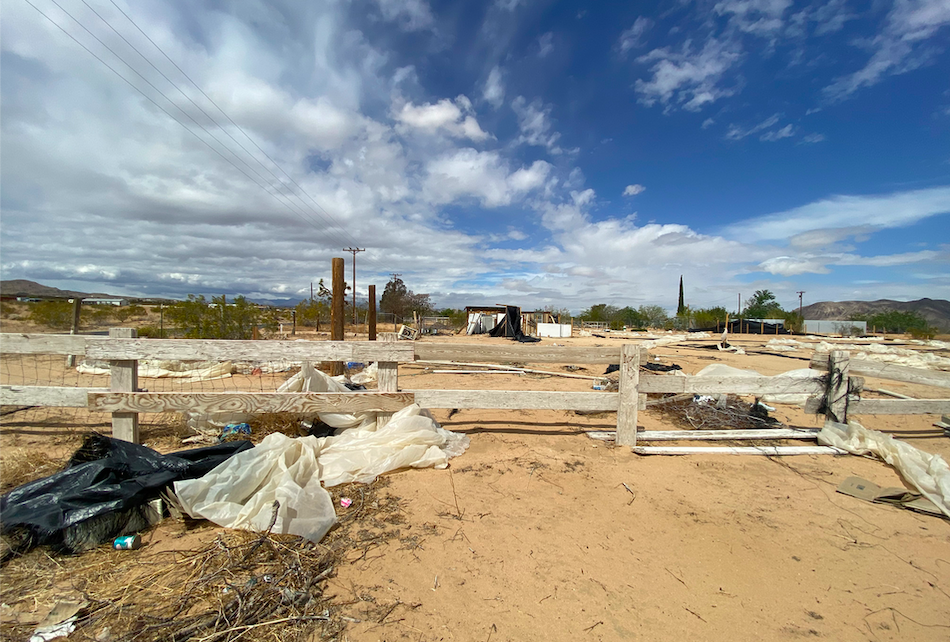
The aftermath of a law enforcement bust of marijuana grow. (Photo: Laura Hauther for California Globe)
Rural CA Communities On Frontlines as Battle Against Illegal Marijuana Cultivation Intensifies
California is the only state to legalize marijuana while dropping the penalty for illegal cultivation to a misdemeanor
By Laura Hauther, July 14, 2021 2:29 am
Rural communities are on the frontlines as the battle against illegal marijuana cultivation intensifies throughout California.
The San Bernardino Sheriffs raided an illegal marijuana grow in 29 Palms in late June. Although these busts have become a common occurrence throughout the Morongo Basin, there was something different about this one.
Instead of acres covered in the now familiar plastic covered hoop grow houses, the plants were in the backyard of a house in of neighborhood where many homes are close to each other on small lots. The night after the raid, neighbors called in a fire at that same house around midnight.
A drone video by Dragon One, an anonymous crusader against these illegal operations, shows just how close the neighboring houses stand. In an area where hot, dry fast moving winds are the norm, the conflagration could have easily turned tragic for many the residents of that development.
Community meetings throughout the Morongo Basin are now dominated by residents bringing their concern, outrage and fear to law enforcement and elected officials. Sargent Rich Debevec from the San Bernardino Marijuana Enforcement Team just confirmed the number of grows has gone up from 860 a few months ago, to a staggering 1027.
Debevec often attends local community meetings as does San Bernardino Supervisor Dawn Rowe and Captain Niles of the Morongo Basin Sheriff’s station to hear concerns and share advice.
Tensions are growing. Residents say they don’t feel safe living next door to large scale operations featuring guard towers, guard dogs and automatic weapons. Light pollution blocks out the night sky. Strong odors from the outdoor grows often invade their homes, and many are concerned with the environmental fallout from excessive water use, pesticides, rodenticides and fertilizers.
Rowe urges her constituents to bring their complaints to the monthly San Bernardino Board of Supervisors meetings to bolster support for her proposals targeted at the illegal grows. Constituents line up at the remote video site at the Bob Burke Government Center to tell their stories to all five Supervisors, hoping to push them toward funding more enforcement measures.
Amy Tessier told of 29 Palms had an encounter with a dog guarding a grow in her neighborhood:
“I was on my morning run when a grey pitbull started to chase me. He bit my thigh and even though the injury wasn’t that serious, I hate to think what might have happened if one of my kids was with me. We don’t feel safe anymore.”
And it’s not just people at risk. Local environmental groups are deeply concerned for the fate of protected species in once were pristine remote areas.
In Kramer Junction, a remote area of San Bernardino County, illegal growers are scraping the land and building massive warehouses in pristine desert tortoise habitat, according to Brendan Cummings, Conservation Director with the Center for Biological Diversity in Joshua Tree.
“The incentive structure with the laws as they are currently written and enforced are not deterring the wide-scale destruction of habitat all across the state.”
The Integral Ecology Research Center created a Cannabis and Ecology Research Program in 2010 after recognizing the heavy toll the illegal grows were having on the wildlife they studied. They’ve done some of the most comprehensive work in identifying and educating the harm some of the chemicals commonly used, like carbofuran. And these chemical don’t just injure wildlife, people exposed to these chemical can suffer serious illness and as the illegal operations get closer to populated areas, so does the risk to the residents.
Frustrated by the failure of current law enforcement tools to make a dent in the problem, the San Bernardino Board of Supervisors unanimously adopted a resolution in June asking the California legislature to return the criminal penalty for illegal cultivation to a felony. A proposition can be altered by the legislature if it follows the purpose and intent of the original proposition. Prop 64 made illegal grows of any size a misdemeanor, creating a perfect environment for illegal grows to take off while taking away business from legal cannabis cultivation and decimating potential California tax funds. Prop 64 main goal was to create a thriving legal cannabis industry that could be taxed and regulated. The illegal growers undermine this goal, so altering those legal penalties is possible.
In a press release Supervisor Rowe made it clear the San Bernardino believes the only remedy is a stiffer criminal penalty:
“State legislators need to step up for our rural communities by approving legislation to make illegal cultivation a felony offense once again.”
Rowe also emphasized the millions of law enforcement dollars San Bernardino is forced to throw at the problem is not a sustainable solution.
The Homestead Valley Community Council (HVCC), an organization representing four rural areas in the Morongo Basin, supports Rowe’s position on the increased criminal penalty. The HVCC have been pushing for stronger eradication measures to slow down the growth of the illegal pot farms, especially in the more remote areas they represent like Landers and Johnson Valley.
James Harvey, President of HVCC, sent a letter on behalf of the Council supporting Prop 64’s legalization of adult use of marijuana, while asking for a return to a felony penalty for illegal marijuana cultivation. The letter points out California is the only state to legalize marijuana while dropping the penalty for illegal cultivation to a misdemeanor, making it all but impossible to protect the legal cannabis industry:
“I think we have to look at it like this,” Harvey told the Globe, “It’s created the biggest tax evasion scheme in our lifetime.”
The letter, addressed to California State Senator Shannon Grove passionately echoes the fear overshadowing rural communities throughout the state:
“No matter has been more devastating to our local communities than the ongoing proliferation of illegal marijuana grow farms, now reaching a magnitude of indescribable epic proportions.”
During one recent HVCC meeting, a resident suggested following Los Angeles County’s lead after their last major raid, Rowe said Los Angeles County will likely find itself in court over some of its enforcement tactics and San Bernardino is focusing on other enforcement options.
“We want to be careful about government overreach,” Rowe said.
During that raid in early June, Los Angeles County Sheriffs used bulldozers to take out 500 Antelope Valley marijuana farms in collaboration with law enforcement from the Drug Enforcement Agency (D.E.A.), the U.S. Army, Ventura and Kern Counties.
“What we want to do is send a clear message to the cartels and anyone doing illegal operations in the High Desert, your days are over and we are coming for you,” Los Angeles County Sheriff Alex Villanueva said in post operation press conference.
The California legislature seems to have little interest in any measure that could be seen as a return to the war on drugs with its history of abuses and the extreme law enforcement tactics used by drug eradication programs like CAMP (Campaign Against Marijuana Planting).
In the 90’s the U.S. Army and National Guard troops joined the efforts, using helicopters and military vehicles causing protests among locals.
Now California is more focused on trying to plug the loopholes in the law by using a carrot and stick approach.
Assembly Bill 1138, introduced by Assembly Member Blanca Rubio and coauthored by Thurston Smith, attempts to slow down illegal grows by going after their profits.
Rather than reverse the decriminalization of cultivation, it’s concentrating on creating stricter civil penalties for growers and those found by a court to be knowingly “aiding and abetting” illegal grows.
Any business leasing land, selling water, soil, fertilizers, plastic sheeting or lumber could be hit with a $30,000 penalty for each violation and for every day the violation continues.
The bill does not address the details of how the fines would be collected, or what further civil or criminal penalties violators would face if the fines remained unpaid.
State level fines might have more support in court than the county fines tried in Siskiyou and other counties. Supervisor Rowe expressed concerns about the efficacy of such fines issued at the county level for San Bernardino.
“Judges in other counties are ruling against big fines saying they’re not really fair.”
AB 97, signed into law last July of 2019, created a smoother path to legal participation in the cannabis industry. It provides assistance to people of color who were historically disproportionately targeted for the use and sale of marijuana and extended provisional licenses to keep the legal supply flowing to customers.
It also includes a $30,000 a day administrative fine for unlicensed cannabis businesses.
The goal is to bring more smaller growers into the legal framework, benefiting the state through increased tax dollars and decreased spending on law enforcement without harsher criminal penalties.
A 2018 report claimed less than 1% of cannabis growers had state licenses due to both the expense of compliance and a patchwork of local prohibitions throughout the state.
But for some California counties, the transformation to a legal, regulated industry isn’t happening fast enough to put the brakes on the harm caused by the burgeoning illegal cannabis farms.
California Attorney General Xavier Becerra claimed up to 29 billion gallons of water can be poached for a large illegal grow complex. In part of their state-wide cleanup, the CAMP team also pulled out 405 miles of water lines and 192 dams used to irrigate grows throughout the state.
A study by the IERC found the rodenticide carbofuran at 80% of the grow sites, a poison so powerful less than a teaspoon can kill a bear. At the latest raid in the Antelope Valley, two dead bears were found near the grow where the chemical was used. When the poison gets into the food chain it wreaks havoc on local wildlife, creating what biologist call a “circle of death.”
Although this has been an issue going back many years – illegal grows were often hidden in state forests and parklands – the current legal structure has allowed these violations to balloon to unprecedented levels near more residential areas.
Ginger Sammito, a resident of Siskiyou County recently posted a video highlighting the environmental devastation left in the wake of these grows. Raw sewage flows into shallow pits or plastic tanks meant for water, garbage is also thrown in shallow pits where winds spread it throughout the landscape. Fuel from generators pour fuel directly on the ground and 55-gallon drums of chemicals of fertilizers, rodenticides and pesticides – many of them unmarked– are strewn around the property.
The illegal grows continue to take over new territory even though last year the Siskiyou Daily News reported the two enforcement teams for the county, the North State Major Investigation Team and the Siskiyou Unified Major Investigation Team seized between $405 million and $607.7 million worth of processed and unprocessed marijuana.
Since 2017 Siskiyou County has renewed their local state of emergency for state funds to assist with enforcement each year with no end in sight.
Siskiyou County is now cracking down on businesses or individuals providing support to illegal grows. Law enforcement can now stop and cite any truck hauling more than 100 gallons of water on certain roads leading to areas with thousands of illegal cannabis grows. The fine is only $100 but they can charge drivers with a misdemeanor and, at the discretion of the officer, impound the vehicle. Permits exempting water trucks used for legal agricultural uses are issues free of charge.
Like San Bernardino, Siskiyou is focused on water usage as California slides back into severe drought. The county also stopped issuing well permits, and well owners supplying water to grows are now in the county’s legal crosshairs:
Kirk Andrus, Siskiyou’s District Attorney is suing two local farmers for selling water to illegal cannabis farmers from their wells. They have not been charged criminally but they could face fines up to $5000 a day.
Businesses supplying soil, lumber and other materials typically used to build grow houses are also in law enforcement’s crosshairs, framing it as “aiding and abetting.” This ordinance sparked furious debate on the Siskiyou County Sheriff’s Facebook page as citizens wondered if local businesses could wind up getting hit with the fine for unintentionally selling to a grower.
Despite the intensifying legal and law enforcement battles on the county level, the response from Sacramento indicates they intend to keep following Prop 64 in its original form.
In a tweet last August, California’s cannabis czar Nicole Elliot, responded to Siskikyou County’s request for another year emergency enforcement funding:
“A friendly reminder to the Siskiyou Board of Supervisors, if you regulate commercial cannabis activity (vs. ban), not only do you create legal and regulated pathways for these grows, you’d also be eligible for FY19/20 $26M Prop 64 enforcement grants.”
There is no sign Siskiyou is considering reversing its ban on marijuana cultivation and given the destruction to the environment and the community caused by illegal cultivation, that is not likely to change any time soon.
Riverside County’s experience is a mixed bag, but it does highlight the benefits of developing a thriving legal cultivation and retail sales market is some areas. The county’s approach to illegal cultivation is all-out war but permitted legal marijuana has brought Desert Hot Springs back from the edge of insolvency.
It was the first city to jump into legalizing industrial cannabis grows as far back as 2014 when medical marijuana was given the green light in California. By 2016 when adult use was legalized other nearby cities like Palm Spring and Cathedral City were on board.
The industry created enough tax revenue to build a new City Hall and library for Desert Hot Springs.
Building on that success, Desert Hot Spring City Council voted to allow cannabis hotels and cannabis entertainment facilities this December. Other cities are following suit.
Complaints are kept to a minimum by strict zoning ordinances keeping the grow houses in an industrial area away from residential sections.
Yet last year, during Becerra’s thirteen-week statewide Campaign Against Marijuana Planting (CAMP), Riverside’s haul of 293,000 plants put them ahead of every other county in the state. Despite that huge haul, another 5,000 were seized in May and in June another 2.5 tons were seized in same area.
The illegal operations were mostly in the Anza area, where large grow operations previously allowed to operate under Prop 215 growing medical marijuana, were cut out of the market under Prop 65 when Riverside decided to prohibit any cultivation in unincorporated areas of the county.
The transition from an illegal to legal industry is proving extremely difficult as enforcement officials navigate the scars left behind from the militaristic, and often racist, drug war tactics of the past.
In an interview with MoneyWorks magazine, Cannabis Czar Nicole Elliot agreed the transition is “likely to be a multiyear project, with no end in sight.”
Elliot emphasized the focus of enforcement needs to be on “environmental damage and high-level criminal activity” instead of mom and pop growers and those in the process of acquiring the necessary licenses. Certain communities were hit with extreme law enforcement tactics during the drug war years, Elliot said, and the state wants to take a different approach now, like Gov. Newsom’s plan to offer 100 million dollars in aid to help businesses trying to stay legal.
According to the Los Angeles Times, the funds will help the 82% of California cannabis businesses still holding provisional licenses.
Newsom also wants to give those businesses a six-month extension past the current Jan. 1 deadline to comply with the provisions of the California Environmental Quality Act. Many environmental groups, including the Sierra Club and the Nature Conservancy are pushing back against this proposal saying it violates the protections guaranteed in Prop 64.
Unless California is willing to return to stronger criminal penalties and a return to drug war tactics; a quicker, clearer and more affordable path to legal cannabis production might be the only way to make headway against its immensely destructive illegal counterpart.





The situation with illegal grows exemplifies why “real” legislation is a much better idea than legislation-by-initiative. The only reason California wound up with Prop 64 is that legislators didn’t have the huevos to write the law and hash it out themselves. They were too scared to do what their constituents wanted, and now CA is stuck with legislation written by cannabis capitalists.
Legal is the way to go
Spending millions to eradicate is crazy and will never work
Making millions taxing is better and easier to keep
Regulated
One wonders how many of the people currently experiencing fear or other fallout from Prop 64 voted for the initiative that helped make it happen. I believe it was H. L. Mencken who observed that Americans get exactly the kind of government they deserve.
Legal should not be so hard to do. It can take 5 years and a lot of money to get permitted for 1 acre on a several hundred acre ranch not close to anyone. After prop 19 passed there are a lot of people with ranches close to the high value bay area looking to cannabis to save the ranch when the title holder dies and property taxes will force the sale of family property. THE BOARD OF REALTORS LIED AND WERE AIDED BY THE SLANTRD BALLOT SUMMARY.